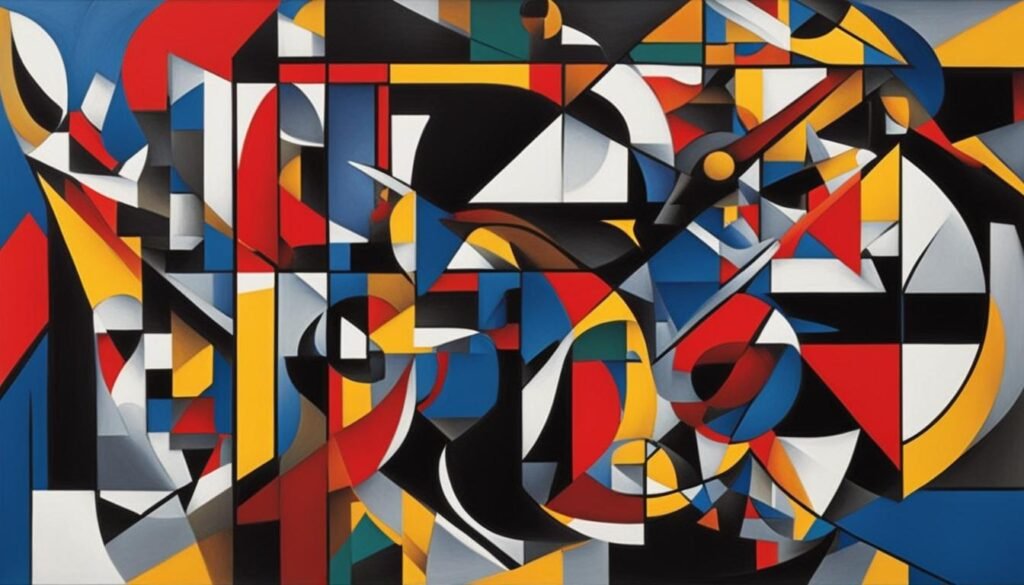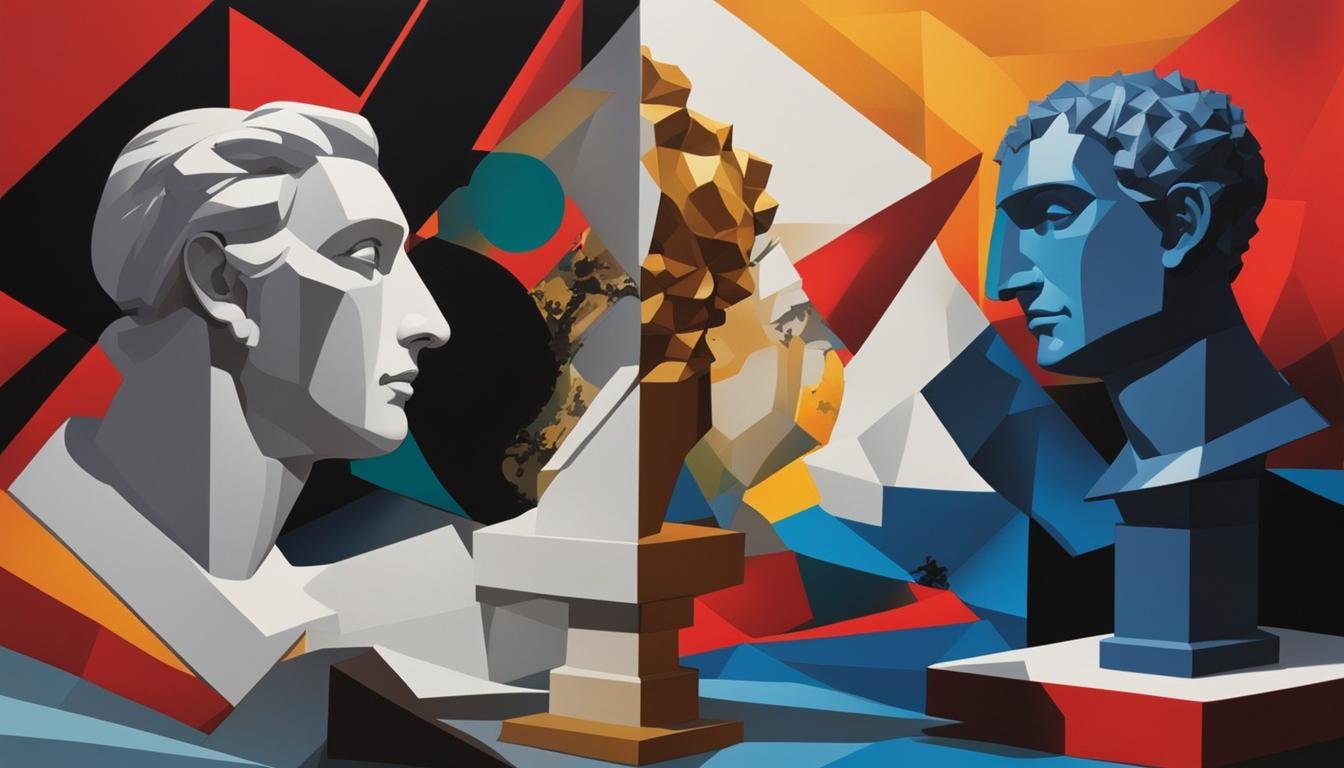Modern art has been a subject of critique and controversy for decades. Its departure from traditional artistic styles and techniques often raises questions about its quality and value. Some may wonder why modern art is so bad or why it is often met with strong criticism. In this article, we will explore the various factors that contribute to the perception of modern art as “bad” and delve into the ongoing debates surrounding its merits.
Throughout history, modern art has faced scrutiny and raised eyebrows. From unconventional techniques to abstract concepts, modern art has challenged traditional notions of beauty and artistic skill. Let’s take a closer look at the reasons behind the critique and controversy.
Key Takeaways:
- Modern art is often criticized for deviating from conventional artistic styles.
- Some perceive modern art as lacking skill, craftsmanship, or meaningful content.
- The difficulty in understanding modern art contributes to its negative perception.
- Controversial artworks and the role of art institutions also play a part in shaping opinions.
- The historical context and societal shifts influence the development of modern art.
Difficulty in Understanding Modern Art
Modern art, with its abstract and unconventional forms, often presents a challenge for viewers. Its departure from traditional artistic techniques and subject matter can make it difficult to interpret the intentions of the artist. Contemporary art, in particular, requires an open mind and an engagement with unconventional forms and ideas. The aesthetics and meaning of modern art can vary widely, leading to diverse interpretations and opinions.
Contemporary art often defies the traditional boundaries of representation, inviting viewers to explore new ways of understanding and appreciating art. It encourages us to question our preconceived notions of what art should be and challenges us to think critically about the world around us. As the art critic Arthur Danto once said, “To see something as art requires something the eye cannot descry—an atmosphere of artistic theory, a knowledge of the history of art: an artworld.” Interpreting modern art, therefore, often involves a deeper engagement with art theory and the historical context in which the artwork was created.
Furthermore, the interpretation of modern art is highly subjective, as it relies on individual perspectives and personal experiences. One person may find a particular artwork profound and thought-provoking, while another may struggle to connect with it. Modern art’s emphasis on individual interpretation allows for a diverse range of responses, contributing to its richness and complexity.
Challenging the Norms
Modern art challenges conventional artistic norms and invites us to expand our horizons. It encourages us to question our preconceived notions of what art should be and challenges us to think critically about the world around us. This can result in a wide range of reactions, from frustration and confusion to fascination and appreciation. Regardless of our individual responses, modern art remains an important and integral part of the artistic landscape, pushing boundaries and inviting us to see the world in new and unexpected ways.
Controversies in Modern Art
Modern art has always been a subject of controversy and debate. Its departure from traditional artistic styles and techniques often elicits strong reactions from critics and the general public. The criticism of modern art ranges from questions about its artistic merit to concerns about its accessibility and relevance. These controversies are fueled by a variety of factors, including the perception of a lack of skill or meaningful content in some contemporary artworks.
One of the main criticisms of modern art is the perceived lack of artistic skill or craftsmanship. Traditional art forms, such as realistic paintings or sculptures, are often considered to be the pinnacle of artistic mastery. In contrast, modern art can be abstract, conceptual, or experimental, challenging the established notions of technical skill and traditional aesthetics. This departure from traditional artistic techniques can lead to skepticism and criticism.
Another source of controversy in modern art is the perceived lack of meaningful content. Some argue that contemporary artworks often prioritize shock value or novelty over substance, leading to artworks that may appear random or meaningless. The unconventional nature of modern art and its emphasis on individual interpretation can also contribute to misunderstandings and conflicting opinions.
It is important to note that controversies in modern art are not inherently negative. They reflect the diversity and dynamism of the art world, sparking discussions about artistic value, societal norms, and the purpose of art. These debates contribute to the evolution of artistic practices and challenge the boundaries of creativity. Whether one agrees or disagrees with modern art, its controversies invite us to reflect on our own perceptions and expand our understanding of artistic expression.
The Value of Skill and Message in Modern Art
When evaluating modern art, two important aspects come into play: the artist’s skill and the message conveyed by the artwork. These factors contribute to the overall appreciation and understanding of contemporary artistic creations.
Firstly, the value of skill in modern art is a topic of debate. Traditional art forms often prioritize technical mastery and craftsmanship. However, modern art challenges these conventional norms by embracing experimentation and pushing the boundaries of artistic expression. While some may criticize contemporary art for its apparent lack of skill or technical finesse, others appreciate the innovative techniques and unconventional approaches employed by modern artists.
Secondly, the message behind a piece of modern art plays a crucial role in its evaluation. Art has always been a medium for communication, and modern art is no exception. Many contemporary artists use their work to address important social, political, or cultural issues. Through symbolism, abstraction, or unconventional subject matter, these artworks stimulate discussion and evoke emotions. The hidden meanings and thought-provoking concepts embedded in modern art can create a deeper connection between the viewer and the artwork.
Appreciating Modern Art: A Personal Journey
“Modern art challenges me to see beyond the surface and engage with the artist’s vision. It’s not always about technical prowess, but rather the ability to convey a powerful message that resonates with the viewer. Each artwork is an invitation to explore my own interpretations and connect with something greater than myself.”
Ultimately, the evaluation and appreciation of modern art are subjective and deeply personal. There is no singular formula for determining the value or significance of a contemporary artwork. Each individual brings their own perspectives, experiences, and preferences to the viewing experience, shaping their interpretation and emotional response to the art. Modern art invites us to question preconceived notions, challenge our biases, and embrace the diversity of artistic expression in today’s world.
The Role of Art Institutions and Elitism
The perception of modern art as “bad” is sometimes attributed to the art establishment and elitism within the art world. Art institutions, gallery owners, and critics play a significant role in shaping public opinion regarding the value and significance of specific artworks. Their influence can contribute to the negative perception of modern art when they promote obscure or controversial pieces as genius, alienating the general public who may struggle to understand or appreciate these works. The perceived elitism and exclusivity associated with the art establishment reinforce the notion that modern art is not accessible to everyone.

Influential Figures in Modern Art
- Pablo Picasso: A pioneer of modern art, Picasso’s innovative approach to form and style revolutionized the art world. His works such as “Les Demoiselles d’Avignon” and “Guernica” challenged traditional artistic conventions and pushed the boundaries of artistic expression.
- Marcel Duchamp: Known for his controversial ready-mades, Duchamp questioned the very definition of art. His work “Fountain,” a mass-produced urinal presented as art, challenged the notion of artistic skill and raised fundamental questions about the nature of art itself.
- Jackson Pollock: A prominent figure in abstract expressionism, Pollock’s unique drip painting technique revolutionized the art world. His large-scale, energetic compositions, such as “No. 5, 1948,” captured the essence of his emotions and brought a new sense of freedom and spontaneity to art.
Modern art is a product of its time, deeply influenced by historical events, cultural shifts, and the perspectives of individual artists. It challenges traditional notions of art, pushing boundaries and inviting viewers to explore new ways of seeing and understanding the world. By studying the historical context of modern art, we gain valuable insights into its development, significance, and enduring relevance.
Conclusion
The perception of modern art as “bad” is subjective and can be influenced by personal preferences, artistic knowledge, and societal norms. While some criticize modern art for its departure from traditional artistic techniques and subject matter, others appreciate its innovation and ability to provoke thought and emotions.
The controversies and debates surrounding modern art contribute to its ongoing relevance and impact on artistic discourse. The shock value and unconventional nature of modern art can polarize opinions and lead to a negative perception by the general public.
Ultimately, the value of modern art lies in the eyes of the beholder, and its significance will continue to evolve as artistic practices evolve. The appreciation of modern art can vary greatly depending on personal tastes and artistic preferences. Modern art challenges our preconceived notions and invites us to question the boundaries of creativity and expression.
FAQ
Why is modern art often criticized as “bad”?
Modern art is often criticized for deviating from conventional artistic styles and lacking skill, craftsmanship, or meaningful content. Some people find it too simplistic or lacking in originality.
What makes modern art difficult to understand?
Modern art, particularly contemporary art, can be challenging to comprehend due to its departure from traditional techniques and subject matter. Abstract and conceptual art, in particular, require an open mind and a willingness to engage with unconventional forms and ideas.
Why does modern art generate controversies?
Modern art has often generated controversies due to the perceived lack of artistic skill or meaningful content in some contemporary artworks. The shock value and unconventional nature of modern art can polarize opinions and lead to a negative perception by the general public.
Does skill and message matter in modern art?
The value of modern art lies in the artist’s skill and the artwork’s ability to convey a meaningful message for many people. When modern art lacks technical mastery or a clear message, it can be perceived as lacking artistic merit.
How does art institutions and elitism affect the perception of modern art?
The decisions made by art institutions, gallery owners, and critics can shape public opinion regarding the value and significance of specific artworks. Perceived elitism and exclusivity within the art world often contribute to the negative perception of modern art by the general public.
What is the historical context of modern art?
Modern art emerged as a response to societal changes brought by industrialization, wars, and globalization. It reflects social, political, and cultural shifts and challenges traditional notions of beauty and skill.
Is the perception of modern art subjective?
Yes, the perception of modern art as “bad” is subjective and can be influenced by personal preferences, artistic knowledge, and societal norms. While some criticize modern art, others appreciate its innovation and ability to provoke thought and emotions.

